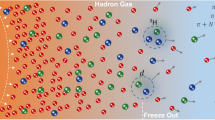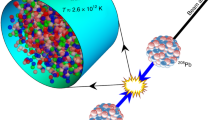Abstract
About 10 μs after the Big Bang, the universe was filled—in addition to photons and leptons—with strong-interaction matter consisting of quarks and gluons, which transitioned to hadrons at temperatures close to kT = 150 MeV and densities several times higher than those found in nuclei. This quantum chromodynamics (QCD) matter can be created in the laboratory as a transient state by colliding heavy ions at relativistic energies. The different phases in which QCD matter may exist depend for example on temperature, pressure or baryochemical potential, and can be probed by studying the emission of electromagnetic radiation. Electron–positron pairs emerge from the decay of virtual photons, which immediately decouple from the strong interaction, and thus provide information about the properties of QCD matter at various stages. Here, we report the observation of virtual photon emission from baryon-rich QCD matter. The spectral distribution of the electron–positron pairs is nearly exponential, providing evidence for a source of temperature in excess of 70 MeV with constituents whose properties have been modified, thus reflecting peculiarities of strong-interaction QCD matter. Its bulk properties are similar to the dense matter formed in the final state of a neutron star merger, as apparent from recent multimessenger observation.
This is a preview of subscription content, access via your institution
Access options
Access Nature and 54 other Nature Portfolio journals
Get Nature+, our best-value online-access subscription
$29.99 / 30 days
cancel any time
Subscribe to this journal
Receive 12 print issues and online access
$209.00 per year
only $17.42 per issue
Buy this article
- Purchase on Springer Link
- Instant access to full article PDF
Prices may be subject to local taxes which are calculated during checkout





Similar content being viewed by others
Data availability
All data shown in figures are publicly available from HEPdata (https://hepdata.net/).
Code availability
The HADES raw data have been analysed with the ROOT-based customized reconstruction software HYDRA and stored in data summary files. Detailed information on the analysis procedures employed can be provided by the authors on request.
References
Andronic, A., Braun-Munzinger, P., Redlich, K. & Stachel, J. Decoding the phase structure of QCD via particle production at high energy. Nature 561, 321–330 (2018).
Borsanyi, S. et al. Is there still any T c mystery in lattice QCD? Results with physical masses in the continuum limit III. J. High Energy Phys. 2010, 73 (2010).
Bazavov, A. et al. Chiral crossover in QCD at zero and non-zero chemical potentials. Phys. Lett. B 795, 15–21 (2019).
Roberts, C. D. Perspective on the origin of hadron masses. Few Body Syst. 58, 5–17 (2017).
Shuryak, E. V. Quark-gluon plasma and hadronic production of leptons, photons and psions. Phys. Lett. B 78, 150–153 (1978).
Kroll, N. M., Lee, T. D. & Zumino, B. Neutral vector mesons and the hadronic electromagnetic current. Phys. Rev. 157, 1376–1399 (1967).
McLerran, L. D. & Toimela, T. Photon and dilepton emission from the quark–gluon plasma: some general considerations. Phys. Rev. D 31, 545–602 (1985).
Gale, C. & Kapusta, J. I. Dilepton radiation from high temperature nuclear matter. Phys. Rev. C 35, 2107–2116 (1987).
Rapp, R. & Wambach, J. Chiral symmetry restoration and dileptons in relativistic heavy ion collisions. Adv. Nucl. Phys. 25, 1 (2000).
Pisarski, R. D. Phenomenology of the chiral phase transition. Phys. Lett. B 110, 155–158 (1982).
Ding, H. T., Kaczmarek, O. & Meyer, F. Thermal dilepton rates and electrical conductivity of the QGP from the lattice. Phys. Rev. D 94, 034504 (2016).
Hohler, P. M. & Rapp, R. Is ρ-meson melting compatible with chiral restoration?. Phys. Lett. B 731, 103–109 (2014).
Jung, C., Rennecke, F., Tripolt, R. A., von Smekal, L. & Wambach, J. In-medium spectral functions of vector- and axial-vector mesons from the functional renormalization group. Phys. Rev. D 95, 036020 (2017).
Specht, H. J. Thermal dileptons from hot and dense strongly interacting matter. AIP Conf. Proc. 1322, 1–10 (2010).
Rapp, R. & van Hees, H. Thermal dileptons as fireball thermometer and chronometer. Phys. Lett. B 753, 586–590 (2016).
Heinz, U. W. & Lee, K. S. The rho peak in the dimuon spectrum as a clock for fireball lifetimes in relativistic nuclear collisions. Phys. Lett. B 259, 162–168 (1991).
Barz, H. W., Friman, B. L., Knoll, J. & Schulz, H. Production of phi, rho and omega mesons in the hadronization of a quark–gluon plasma. Phys. Lett. B 254, 315–319 (1991).
Adamova, D. et al. Enhanced production of low mass electron pairs in 40-AGeV Pb–Au collisions at the CERN SPS. Phys. Rev. Lett. 91, 042301 (2003).
Agakishiev, G. et al. Low mass e+e− pair production in 158/A-GeV Pb–Au collisions at the CERN SPS, its dependence on multiplicity and transverse momentum. Phys. Lett. B 422, 405–412 (1998).
Arnaldi, R. et al. First measurement of the rho spectral function in high-energy nuclear collisions. Phys. Rev. Lett. 96, 162302 (2006).
Adare, A. et al. Dielectron production in Au + Au collisions at \(\sqrt{SNN} = 200\ {\mathrm{Gev}}\). Phys. Rev. C 93, 014904 (2016).
Adamczyk, L. et al. Measurements of dielectron production in Au + Au collisions at \(\sqrt{SNN} = 200\ {\mathrm{Gev}}\) from the STAR experiment. Phys. Rev. C 92, 024912 (2015).
Adam, J. et al. Measurements of dielectron production in Au + Au collisions at \(\sqrt{SNN} = 27,39\), and 62.4 GeV from the STAR experiment. Preprint at https://arxiv.org/abs/1810.10159 (2018).
Herrmann, M., Friman, B. L. & Nörenberg, W. Properties of rho mesons in nuclear matter. Nucl. Phys. A 560, 411–436 (1993).
Chanfray, G. & Schuck, P. The Rho meson in dense matter and its influence on dilepton production rates. Nucl. Phys. A 555, 329–353 (1993).
Peters, W., Post, M., Lenske, H., Leupold, S. & Mosel, U. The spectral function of the rho meson in nuclear matter. Nucl. Phys. A 632, 109–127 (1998).
Wilson, W. K. et al. Inclusive dielectron cross-sections in p + p and p + d interactions at beam energies from 1.04-GeV to 4.88-GeV. Phys. Rev. C 57, 1865–1878 (1998).
Porter, R. J. et al. Dielectron cross-section measurements in nucleus-nucleus reactions at 1-A/GeV. Phys. Rev. Lett. 79, 1229–1232 (1997).
Agakishiev, G. et al. Origin of the low-mass electron pair excess in light nucleus-nucleus collisions. Phys. Lett. B 690, 118–122 (2010).
Adamczewski-Musch, J. et al. Analysis of the exclusive final state npe+e− in quasi-free np reaction. Eur. Phys. J. A 53, 149–161 (2017).
Agakichiev, G. et al. Dielectron production in C-12 + C-12 collisions at 2-AGeV with HADES. Phys. Rev. Lett. 98, 052302 (2007).
Agakishiev, G. et al. Study of dielectron production in C + C collisions at 1-A-GeV. Phys. Lett. B 663, 43–48 (2008).
Agakishiev, G. et al. Dielectron production in Ar + KCl collisions at 1.76A GeV. Phys. Rev. C 84, 014902 (2011).
Bratkovskaya, E. L. et al. System size and energy dependence of dilepton production in heavy-ion collisions at 1-2 GeV/nucleon energies. Phys. Rev. C 87, 064907 (2013).
Weil, J., van Hees, H. & Mosel, U. Dilepton production in proton-induced reactions at SIS energies with the GiBUU transport model. Eur. Phys. J. A 48, 111–126 (2012).
Staudenmaier, J., Weil, J., Steinberg, V., Endres, S. & Petersen, H. Dilepton production and resonance properties within a new hadronic transport approach in the context of the GSI-HADES experimental data. Phys. Rev. C 98, 054908 (2018).
Galatyuk, T., Hohler, P. M., Rapp, R., Seck, F. & Stroth, J. Thermal dileptons from coarse-grained transport as fireball probes at SIS energies. Eur. Phys. J. A 52, 131–139 (2016).
Endres, S., van Hees, H., Weil, J. & Bleicher, M. Dilepton production and reaction dynamics in heavy-ion collisions at SIS energies from coarse-grained transport simulations. Phys. Rev. C 92, 014911 (2015).
Lang, A. et al. Local thermodynamic properties and equilibration in relativistic heavy ion collisions. Phys. Lett. B 245, 147–152 (1990).
Seck, F., Galatyuk, T., Rapp, R. & Stroth, J. Thermal dileptons as QCD matter probes at SIS. J. Phys. Conf. Ser. 1024, 012011 (2018).
Bauswein, A., Goriely, S. & Janka, H.-T. Systematics of dynamical mass ejection, nucleosynthesis, and radioactively powered electromagnetic signals from neutron-star mergers. Astrophys. J. 773, 78 (2013).
Most, E. R. et al. Signatures of quark-hadron phase transitions in general-relativistic neutron-star mergers. Phys. Rev. Lett. 122, 061101 (2019).
Rapp, R. Hadro chemistry and evolution of (anti-) baryon densities at RHIC. Phys. Rev. C 66, 017901 (2002).
Guenther, J. N. et al. The QCD equation of state at finite density from analytical continuation. Nucl. Phys. A 967, 720–723 (2017).
Bass, S. A. et al. Microscopic models for ultrarelativistic heavy ion collisions. Prog. Part. Nucl. Phys. 41, 255–369 (1998).
Floerchinger, S. & Wetterich, C. Chemical freeze-out in heavy ion collisions at large baryon densities. Nucl. Phys. A 890-891, 11–24 (2012).
Agakishiev, G. et al. The High-Acceptance Dielectron Spectrometer HADES. Eur. Phys. J. A 41, 243–277 (2009).
Adamczewski-Musch, J. et al. Centrality determination of Au + Au collisions at 1.23 A GeV with HADES. Eur. Phys. J. A 54, 85 (2018).
Harabasz, S. Reconstruction of Virtual Photons from Au + Au Collisions at 1.23 GeV/u. PhD Thesis, Tech. Univ. Darmstadt and Jagiellonian Univ. Cracow (2017).
Hocker, A. et al. TMVA, the Toolkit for Multivariate Data Analysis with ROOT. PoS(ACAT)040 (2007).
Sellheim, P. Reconstruction of the Low-Mass Dielectron Signal in 1.23 A GeV Au + Au Collisions. PhD Thesis, Goethe-Univ. Frankfurt (2017).
Fröhlich, I. et al. Design of the Pluto Event Generator. J. Phys. Conf. Ser. 219, 032039 (2010).
Averbeck, R. et al. Neutral pions and eta mesons as probes of the hadronic fireball in nucleus-nucleus collisions around 1-A-GeV. Phys. Rev. C 67, 024903 (2003).
Adamczewski-Musch, J. et al. Deep sub-threshold ϕ production in Au + Au collisions. Phys. Lett. B 778, 403–407 (2018).
Acknowledgements
The collaboration gratefully acknowledges the support by PTDC/FIS/113339/2009 LIP Coimbra (Portugal), 2013/10/M/ST2/00042, 2016/23/P/ST2/040 POLONEZ, 2017/25/N/ST2/00580, 2017/26/M/ST2/00600 SIP JUC Cracow, National Science Centre (Poland), VH-NG-823, DFG GRK 2128, DFG CRC-TR 211, ExtreMe Matter Institute EMMI at the GSI, BMBF:05P18RDFC1 TU Darmstadt (Germany), EU FP7:283286, BMBF:05P12CRGHE HZDR Dresden (Germany), HIC for FAIR (LOEWE), GSI F&E, EMMI, BMBF:05P15RFFCA Goethe-Universität, Frankfurt (Germany), DFG EClust 153, GSI F&E:TMLRG1316F, BMBF:05P15WOFCA, SFB 1258, DFG FAB898/2-2 TU München, Garching (Germany), BMBF:05P12RGGHM JLU Giessen, Giessen (Germany), INFN-LNS Catania, Catania (Italy), Russian Academic Excellence 02.a03.21.0005, Minobrnauka 3.3380.2017/4.6 NRNU MEPhI Moscow (Russia), UCY/3411-23100, University Cyprus (Cyprus), CNRS/IN2P3 IPN Orsay (France), AS CR M100481202, GACR 13-06759S, MSMT LM2015049, PO VVV CZ.02.1.01/0.0/0.0/16_013/0001677 and MSMT LTT17003 NPI CAS Rez (Czech Republic).
Author information
Authors and Affiliations
Consortia
Contributions
All authors have contributed equally to the publication, being variously involved in the design and the construction of the detectors, writing software, calibrating subsystems, operating the detectors and acquiring data, and finally analysing the processed data.
Corresponding author
Ethics declarations
Competing interests
The authors declare no competing interests.
Additional information
Publisher’s note: Springer Nature remains neutral with regard to jurisdictional claims in published maps and institutional affiliations.
Supplementary information
Supplementary Information
Supplementary figures.
Rights and permissions
About this article
Cite this article
The HADES Collaboration. Probing dense baryon-rich matter with virtual photons. Nat. Phys. 15, 1040–1045 (2019). https://doi.org/10.1038/s41567-019-0583-8
Received:
Accepted:
Published:
Issue Date:
DOI: https://doi.org/10.1038/s41567-019-0583-8
This article is cited by
-
Oscillating features in the electromagnetic structure of the neutron
Nature Physics (2021)
-
Fireball spectroscopy
Nature Physics (2019)



